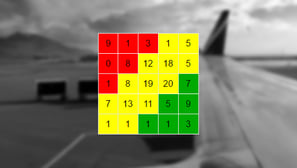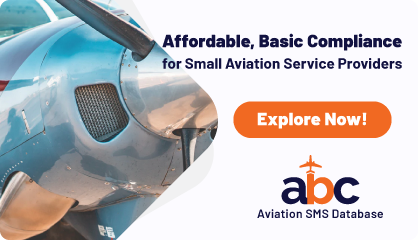
In the high-stakes world of aviation, where safety is paramount, a robust Safety Management System (SMS) is essential for identifying and mitigating risks to prevent incidents. For aviation safety managers and accountable executives—senior leaders responsible for SMS oversight—prioritizing mitigation efforts efficiently is a critical challenge. The risk matrix, a cornerstone tool in aviation safety risk management, provides a structured method to assess and prioritize risks based on their severity and likelihood. By enabling data-driven decisions, the risk matrix ensures resources are allocated effectively to address the most critical hazards.
This evergreen blog article explains
- how a risk matrix works,
- how it prioritizes mitigation efforts within an SMS, and
- how to apply it in aviation operations.
With practical examples, step-by-step guidance, and actionable tips, this resource empowers safety managers and executives to strengthen safety performance and demonstrate compliance with standards set by the International Civil Aviation Organization (ICAO) and national authorities like the FAA or EASA.
What Is a Risk Matrix and Why Is It Important?
A risk matrix is a visual tool used to evaluate risks by plotting their severity (the potential impact of a hazard) against their likelihood (the probability of occurrence). Typically presented as a grid, the matrix categorizes risks into levels—such as low, medium, high, or critical—guiding organizations on which risks require immediate action and which can be monitored.
In aviation SMS, the risk matrix aligns with the safety risk management (SRM) pillar, which involves identifying hazards, assessing risks, and implementing controls. By prioritizing mitigation efforts, the risk matrix helps organizations:
-
Focus resources on high-priority risks to prevent incidents.
-
Demonstrate to regulators a systematic approach to compliance.
-
Enhance decision-making by providing a clear, objective framework.
-
Foster a proactive safety culture by addressing risks before they escalate.
For safety managers, the risk matrix simplifies training employees on risk assessment, while for accountable executives, it supports strategic oversight and resource allocation. Let’s explore how to use a risk matrix to prioritize mitigation efforts effectively.
Related Articles on Aviation SMS Risk Matrix
- What Is a Risk Matrix and Risk Assessment in Aviation SMS
- How to Define Severity and Likelihood Criteria on Your Risk Matrix
- How to Create Your Risk Matrix for Risk Assessments in Aviation SMS
Step 1: Understand the Components of a Risk Matrix
A risk matrix typically consists of a grid with axes for severity and likelihood, each divided into categories. Understanding these components is the foundation for effective use.
Severity Categories
Severity measures the potential consequences of a risk, such as injury, damage, or operational disruption. Common categories include:
-
Negligible: Minor inconvenience (e.g., brief delay).
-
Minor: Limited impact (e.g., minor equipment damage).
-
Moderate: Significant impact (e.g., injury or major delay).
-
Major: Severe consequences (e.g., serious injury or aircraft damage).
-
Catastrophic: Disastrous outcomes (e.g., loss of life or aircraft).
Likelihood Categories
Likelihood assesses how probable it is for the risk to occur. Common categories include:
-
Rare: Almost inconceivable (e.g., once in a decade).
-
Unlikely: Possible but improbable (e.g., once every few years).
-
Possible: Could occur occasionally (e.g., once a year).
-
Likely: Expected to occur frequently (e.g., monthly).
-
Almost Certain: Occurs regularly (e.g., weekly).
Risk Levels
The intersection of severity and likelihood determines the risk level, often color-coded:
-
Low (Green): Acceptable, monitor only.
-
Medium (Yellow): Requires mitigation if feasible.
-
High (Red): Immediate action needed.
-
Critical (Dark Red): Stop operations until resolved.
Actionable Tip: Create a standardized risk matrix template for your organization, aligned with ICAO Annex 19, FAA Part 5 or EASA guidelines. Share it with the safety team and accountable executive to ensure consistency.
Step 2: Identify Hazards and Assess Risks
Before using the risk matrix, identify hazards through employee reports, audits, or incident investigations. Then, assess each hazard’s risk using the matrix to determine its priority.
Hazard Identification
Hazards are conditions or events that could lead to harm, such as wildlife on runways, outdated procedures, or equipment failures. Sources include:
-
Hazard reporting systems (e.g., mobile apps).
-
Safety audits or inspections.
-
Incident or near-miss reports.
Risk Assessment Process
-
Describe the Hazard: Clearly define the hazard and its potential impact.
-
Determine Severity: Estimate the worst-case outcome if the hazard occurs.
-
Estimate Likelihood: Assess how often the hazard is likely to occur.
-
Plot on the Matrix: Place the hazard on the matrix to determine its risk level.
Example 1: Wildlife Hazard
-
Hazard: Frequent bird activity near a regional airport’s runway.
-
Severity: Major (potential for bird strikes causing engine damage or injury).
-
Likelihood: Likely (birds observed weekly during migration season).
-
Matrix Placement: High risk (Major x Likely).
-
Priority: Immediate mitigation required, such as installing bird deterrents.
Actionable Tip: Train employees to report hazards using a simple form or app, including details like location and frequency. Use these reports to feed into the risk matrix assessment.
Related Articles on Aviation Risk Assessments
- How to Perform Risk Assessments Without Aviation Risk Management Software
- How to Justify Severity of Risk Assessments - Best Practices
- How to Be Compliant With ICAO Safety Risk Assessment and Mitigation
Step 3: Prioritize Mitigation Efforts Using the Risk Matrix
The risk matrix guides prioritization by highlighting which risks require urgent action. High and critical risks take precedence, while low risks may be monitored.
Prioritization Guidelines
-
Critical Risks: Halt operations or implement interim controls immediately (e.g., grounding aircraft with critical faults).
-
High Risks: Develop and implement mitigation plans within days or weeks (e.g., equipment upgrades).
-
Medium Risks: Plan mitigations within months, balancing resource availability.
-
Low Risks: Monitor without immediate action, reassessing periodically.
Example 2: Outdated Procedure
-
Hazard: An outdated maintenance checklist missing a critical step for engine inspections.
-
Severity: Catastrophic (could lead to engine failure and loss of life).
-
Likelihood: Unlikely (inspections are rare, and other checks may catch issues).
-
Matrix Placement: High risk (Catastrophic x Unlikely).
-
Priority: Update the checklist within one week and retrain mechanics.
Example 3: Slippery Tarmac
-
Hazard: Slippery tarmac due to oil spills during refueling.
-
Severity: Moderate (potential for minor injuries or delays).
-
Likelihood: Possible (spills occur occasionally).
-
Matrix Placement: Medium risk (Moderate x Possible).
-
Priority: Implement spill cleanup protocols within one month.
Actionable Tip: Create a hazard risk register to track all assessed risks associated with identified hazards, including their matrix placement, priority, and mitigation status. Review it monthly with the safety team and accountable executive.
Related Articles on Hazard Registers in Aviation SMS
- Tips Tying Corrective Action Preventive Action to Hazard Register
- Winter Fatigue Hazard Register Review - Aviation SMS SRM & SA Example
Step 4: Develop and Implement Mitigation Measures
Once risks are prioritized, develop mitigation measures to reduce severity, likelihood, or both. The risk matrix informs the urgency and scale of these measures.
Mitigation Strategies
-
Elimination: Remove the hazard (e.g., relocate a runway away from wildlife habitats).
-
Substitution: Replace the hazard with a safer alternative (e.g., use non-slip tarmac coatings).
-
Engineering Controls: Install physical barriers (e.g., bird netting).
-
Administrative Controls: Update procedures or training (e.g., new checklists).
-
Personal Protective Equipment (PPE): Provide safety gear (e.g., non-slip boots).
Example Mitigation: Wildlife Hazard
-
Measure: Install a $30,000 bird deterrent system (engineering control) and train ground crew on wildlife monitoring (administrative control).
-
Impact: Reduces likelihood from Likely to Unlikely, lowering the risk to Medium (Major x Unlikely).
-
Implementation: System installed within 30 days; training completed in two sessions.
-
Outcome: Bird strike incidents drop by 40% within six months.
Actionable Tip: Propose a mitigation budget to the accountable executive, detailing costs and expected risk reduction for high-priority risks. Use matrix outcomes to justify investments.
Related Articles on Risk Mitigation in Aviation SMS
- What Is Risk Mitigation in Aviation SMS
- Risk Assessment and Mitigation: Identifying Hazards and Reducing Operational Risks
- Risk Mitigation Best Practices in Aviation Safety Management
Step 5: Monitor and Reassess Risks
Risk management is an ongoing process. After implementing mitigations, monitor their effectiveness and reassess risks using the matrix to ensure they remain at acceptable levels.
Monitoring Methods
-
Data Analysis: Track incident rates or hazard reports to measure mitigation impact.
-
Audits: Conduct internal audits to verify controls are working.
-
Employee Feedback: Survey staff on mitigation effectiveness (e.g., ease of new procedures).
-
Reassessment: Replot risks on the matrix after mitigations to confirm reduced severity or likelihood.
Example Reassessment: Outdated Procedure
-
Initial Risk: High (Catastrophic x Unlikely).
-
Mitigation: Updated checklist and retraining completed.
-
Reassessment: Severity remains Catastrophic, but likelihood drops to Rare due to rigorous checks.
-
New Risk: Medium (Catastrophic x Rare).
-
Outcome: The risk is now acceptable, with ongoing monitoring via audits.
Actionable Tip: Schedule quarterly risk reassessments, updating the hazard risk register and sharing results with the accountable executive to demonstrate proactive safety assurance.
Step 6: Communicate and Train on the Risk Matrix
To embed the risk matrix in your SMS, communicate its purpose and train employees on its use. This supports the SMS pillar of safety promotion and fosters a safety culture.
Communication Strategies
-
Safety Briefings: Explain the risk matrix in team meetings, using examples like the wildlife hazard.
-
Newsletters: Share success stories of mitigated risks, linking to matrix prioritization.
-
Posters: Display a simplified risk matrix in crew rooms with instructions for hazard reporting.
Training Approach
-
Overview: Introduce the matrix’s purpose and components (severity, likelihood, risk levels).
-
Hands-On Exercise: Have employees assess a hypothetical hazard using the matrix.
-
Case Studies: Use real examples, like the outdated checklist, to show prioritization in action.
-
Executive Involvement: Invite the accountable executive to open training sessions, reinforcing leadership.
Example Training Session
30-Minute Workshop for Ground Crew:
-
5 min: Explain the risk matrix and its role in SMS.
-
10 min: Present the slippery tarmac example, plotting it on the matrix.
-
10 min: Group activity—employees assess a mock hazard (e.g., loose runway gravel).
-
5 min: Q&A and handout with matrix template.
-
Outcome: 90% of 50 trainees correctly plot a hazard, and hazard reporting rises by 20% in three months.
Actionable Tip: Develop a 2-minute video explaining the risk matrix, featuring the accountable executive. Host it on the company intranet for easy access.
Related Aviation SMS Risk Matrix Articles
- How to Define Your Risk Matrix in Aviation SMS
- Guide to Define Risk Matrix Probability and Severity in Aviation Safety
- Safety Chart: How to Monitor Aviation Risk Management Priorities Using Heat Maps
Overcoming Common Challenges
Safety managers and executives often face hurdles in using risk matrices. Here’s how to address them:
-
Subjectivity: Standardize severity and likelihood definitions to reduce bias, using historical data or industry benchmarks.
-
Resource Constraints: Prioritize high and critical risks to optimize limited budgets, as shown in the examples.
-
Employee Skepticism: Share success stories, like the wildlife hazard mitigation, to build trust in the matrix.
-
Complexity: Simplify training with visuals and case studies to make the matrix accessible.
Actionable Tip: Host a 1-hour risk matrix workshop, using the examples above, to align safety teams and executives on its use.
Example: Comprehensive Risk Matrix Application
Hazard: Faulty runway lighting at a small airport.
-
Step 1: Assessment:
-
Severity: Major (potential for runway incursions or crashes).
-
Likelihood: Possible (failures occur occasionally due to aging equipment).
-
Risk Level: High (Major x Possible).
-
-
Step 2: Prioritization: Immediate action required due to high risk.
-
Step 3: Mitigation:
-
Measure: Allocate $50,000 to replace lighting and train staff on maintenance checks.
-
Impact: Reduces likelihood to Rare, lowering risk to Medium (Major x Rare).
-
-
Step 4: Implementation: Lighting replaced in 45 days; training completed in two sessions.
-
Step 5: Monitoring: Quarterly inspections confirm 100% lighting functionality; no incidents reported in six months.
-
Outcome: The accountable executive presents the case to regulators, earning praise for proactive risk management.
Actionable Tip: Use this example in safety meetings to illustrate the full risk matrix process, from assessment to monitoring.
Conclusion: Prioritize Safety with a Risk Matrix
A risk matrix is a powerful tool for prioritizing mitigation efforts in aviation SMS, enabling safety managers and accountable executives to focus resources on the most critical risks. By
- assessing severity and likelihood,
- prioritizing actions,
- implementing mitigations, and
- monitoring outcomes, organizations can prevent incidents, ensure compliance, and foster a proactive safety culture.
The examples of wildlife hazards, outdated procedures, and runway lighting demonstrate how the matrix drives real-world safety improvements.
Start by developing a risk matrix template for your organization and training staff on its use. Use the risk register to track priorities and engage the accountable executive to secure resources for high-priority mitigations. With a systematic approach, you’ll not only meet regulatory requirements but also protect lives and assets for years to come.
Call to Action: Ready to enhance your SMS? Create a risk matrix today and assess one hazard using the steps above. Share this article with your team to align on risk management strategies.
SMS Pro supports custom risk matrices, hazard registers, safety meeting management, auditing tools and much more.





